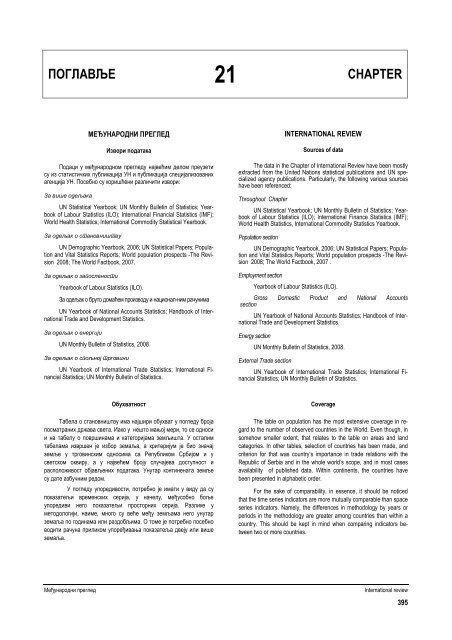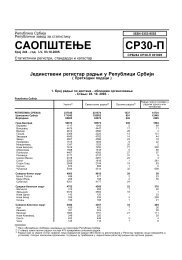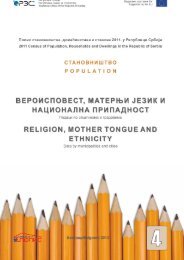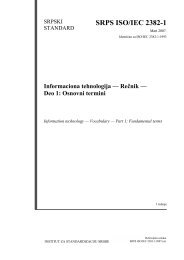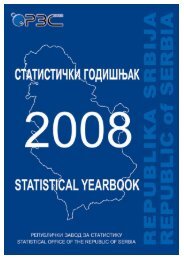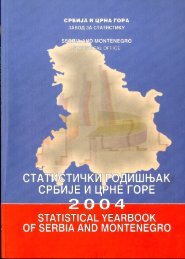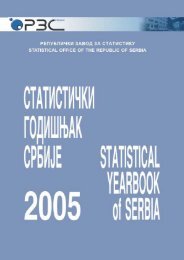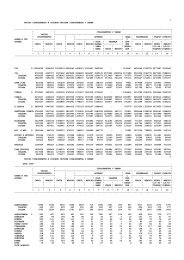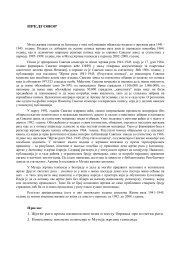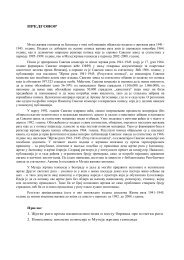Републички завод за статистикуStatistical Office of the Republic of SerbiaПОГЛАВЉЕ 21 CHAPTERМЕЂУНАРОДНИ ПРЕГЛЕДИзвори податакаПодаци у међународном прегледу највећим делом преузетису из <strong>статистички</strong>х публикација УН и публикација специјализованихагенција УН. Посебно су коришћени различити извори:За више одељакаUN Statistical Yearbook; UN Monthly Bulletin of Statistics; Yearbookof Labour Statistics (ILO); International Financial Statistics (IMF);World Health Statistics; International Commodity Statistical Yearbook.За одељак о становништвуUN Demographic Yearbook, 2006; UN Statistical Papers; Populationand Vital Statistics Reports; World population prospects -The Revision2008; The World Factbook, 2007.За одељак о запосленостиYearbook of Labour Statistics (ILO).За одељак о бруто домаћем производу и национал-ним рачунимаUN Yearbook of National Accounts Statistics; Handbook of InternationalTrade and Development Statistics.За одељак о енергијиUN Monthly Bulletin of Statistics, 2008.За одељак о спољној трговиниUN Yearbook of International Trade Statistics; International FinancialStatistics; UN Monthly Bulletin of Statistics.INTERNATIONAL REVIEWSources of dataThe data in the Chapter of International Review have been mostlyextracted from the United Nations <strong>statistical</strong> publications and UN specializedagency publications. Particularly, the following various sourceshave been referenced:Throughout ChapterUN Statistical Yearbook; UN Monthly Bulletin of Statistics; Yearbookof Labour Statistics (ILO); International Finance Statistics (IMF);World Health Statistics, International Commodity Statistics Yearbook.Population sectionUN Demographic Yearbook, 2006; UN Statistical Papers; Populationand Vital Statistics Reports; World population prospects -The Revision2008; The World Factbook, 2007 .Employment sectionYearbook of Labour Statistics (ILO).Gross Domestic Product and National AccountssectionUN Yearbook of National Accounts Statistics; Handbook of InternationalTrade and Development Statistics.Energy sectionUN Monthly Bulletin of Statistics, 2008.External Trade sectionUN Yearbook of International Trade Statistics; International FinancialStatistics; UN Monthly Bulletin of Statistics.ОбухватностTабела о становништву има најшири обухват у погледу бројапосматраних држава света. Иако у нешто мањој мери, то се односии на табелу о површинама и категоријама земљишта. У осталимтабелама извршен је избор земаља, а критеријум је био значајземље у трговинским односима са Републиком Србијом и усветском оквиру, а у највећем броју случајева доступност ирасположивост објављених података. Унутар континената земљесу дате азбучним редом.У погледу упоредивости, потребно је имати у виду да супоказатељи временских серија, у начелу, међусобно бољеупоредиви него показатељи просторних серија. Разлике уметодологији, наиме, много су веће међу земљама него унутарземаља по годинама или раздобљима. О томе је потребно посебноводити рачуна приликом упоређивања показатеља двеју или вишеземаља.CoverageThe table on population has the most extensive coverage in regardto the number of observed countries in the World. Even though, insomehow smaller extent, that relates to the table on areas and landcategories. In other tables, selection of countries has been made, andcriterion for that was country’s importance in trade relations with theRepublic of Serbia and in the whole world’s scope, and in most casesavailability of published data. Within continents, the countries havebeen presented in alphabetic order.For the sake of comparability, in essence, it should be noticedthat the time series indicators are more mutually comparable than spaceseries indicators. Namely, the differences in methodology by years orperiods in the methodology are greater among countries than within acountry. This should be kept in mind when comparing indicators betweentwo or more countries.Међународни прегледInternational review395
Статистички <strong>годишњак</strong> Републике Србије <strong>2012</strong> Statistical <strong>yearbook</strong> of the Republic of Serbia <strong>2012</strong>21.1. СТАНОВНИШТВО И ПОВРШИНА 1) POPULATION AND AREA 1)Процењен бројстановникасрединомгодине 1) , хиљ.Estimatedmid-year population1) , thous.Површина 1) ,km 2Area 1) , km 2Становништво 1) ,на 1 km 2Population 1) ,per km 2Главни град / CapitalБрој становника, хиљ. / Population, thous.ЕвропаEuropeАлбанија Albania 3194 28748 111 Тирана 2008 393 TiraneАндора Andorra 85 468 179 Андора 2010 23 Andorra la VellaАустрија Austria 8365 83871 100 Беч 2010 1698 ViennaБелгија Belgium 10796 30528 349 Брисел 2008 147 BrusselsБелорусија Belarus 9665 207600 46 Минск 2008 1815 MinskБосна и Херцеговина Bosnia and Herzegovina 3843 51197 74 Сарајево 2008 527 SarajevoБугарска Bulgaria 7585 110879 68 Софија 2008 1160 SofiaВелика Британија United Kingdom 61811 242900 254 Лондон 2008 … LondonГрузија Georgia … … … Тбилиси 2008 … TbilisiГрчка Greece 11283 131957 86 Атина 2008 789 AthensДанска Denmark 5519 43094 128 Копенхаген 2008 512 CopenhagenЕстонија Estonia 1340 45227 30 Талин 2008 398 TallinnИрска Ireland 4459 70273 63 Даблин 2008 496 DublinИсланд Iceland 319 103000 3 Рејкјавик 2008 120 ReykjavikИталија Italy 60193 301336 200 Рим 2008 2711 RomeЛетонија Latvia 2255 64559 35 Рига 2008 715 RigaЛитванија Lithuania 3339 65300 51 Виљнус 2008 545 VilniusЛуксембург Luxembourg 498 2586 192 Луксембург 2008 87 LuxembourgМађарска Hungary 10023 93028 108 Будимпешта 2008 1707 BudapestМакедонија Macedonia 2051 25713 80 Скопље 2008 527 SkopjeМалта Malta 413 316 1314 Валета 2008 6 VallettaМолдавија Moldova 3566 33846 106 Кишињев 2010 663 ChisinauМонако Monaco … 2 15 Монако 2008 32 MonacoНемачка Germany 81902 357114 231 Берлин 2008 3387 BerlinНорвешка Norway 4829 323782 13 Осло 2008 568 OsloПољска Poland 38153 312685 118 Варшава 2008 1705 WarsawПортугалија Portugal 10632 92090 116 Лисабон 2008 490 LisbonРумунија Romania 21470 238391 90 Букурешт 2008 1944 BucharestРуска Федерација Russian Federation 141909 17098242 8 Москва 2008 10490 MoscowРепублика Словачка Slovakia 5418 49037 111 Братислава 2008 428 BratislavaСловенија Slovenia 2042 20273 100 Љубљана 2008 265 LjubljanaРепублика Србија Republic of Serbia 7321 88361 112 Београд 2) 2008 1621 Belgrade 2)Украјина Ukraine 46053 603500 76 Кијев 2008 2699 KievФинска Finland 5311 338424 16 Хелсинки 2008 574 HelsinkiФранцуска France 62621 551500 113 Париз 2008 2126 ParisХоландија Netherlands 16530 37354 399 Амстердам 2010 767 AmsterdamХрватска Croatia 4429 56594 78 Загреб 2008 692 ZagrebЧешка Република Czech Republic 10491 78865 132 Праг 2008 1233 PragueШвајцарска Switzerland 7744 41277 185 Берн 2008 122 BernШведска Sweden 9299 450295 21 Стокхолм 2008 789 StockholmШпанија Spain 45929 505992 90 Мадрид 2008 3213 Madrid1) Подаци преузети из UN Demographic Yearbook, 2009-10. 1) UN Demographic Yearbook, 2009-10Међународни преглед396International review
- Page 2 and 3:
РЕПУБЛИЧКИ ЗАВОД З
- Page 4 and 5:
П Р Е Д Г О В О Р„Ста
- Page 6:
САДРЖАЈПРЕДГОВОР ..
- Page 9 and 10:
18.5. Издаци за истра
- Page 11 and 12:
5.16. Pupils’ hostels, beneficiar
- Page 13 and 14:
17. INFORMATION TECHNOLOGIES ......
- Page 15 and 16:
ЗНАЦИSYMBOLS− = нема п
- Page 17 and 18:
Обухватност и упор
- Page 19 and 20:
Статистички годишњ
- Page 21 and 22:
Статистички годишњ
- Page 23 and 24:
Статистички годишњ
- Page 25 and 26:
Статистички годишњ
- Page 27 and 28:
Статистички годишњ
- Page 29 and 30:
Статистички годишњ
- Page 31 and 32:
Статистички годишњ
- Page 33 and 34:
Статистички годишњ
- Page 35 and 36:
Статистички годишњ
- Page 37 and 38:
Статистички годишњ
- Page 39 and 40:
Статистички годишњ
- Page 41 and 42:
Статистички годишњ
- Page 43 and 44:
Статистички годишњ
- Page 45 and 46:
Статистички годишњ
- Page 47 and 48:
Статистички годишњ
- Page 49 and 50:
Статистички годишњ
- Page 51 and 52:
Статистички годишњ
- Page 53 and 54:
Статистички годишњ
- Page 55 and 56:
Статистички годишњ
- Page 57 and 58:
Статистички годишњ
- Page 59 and 60:
Статистички годишњ
- Page 61 and 62:
Статистички годишњ
- Page 63 and 64:
Статистички годишњ
- Page 65 and 66:
Статистички годишњ
- Page 67 and 68:
Статистички годишњ
- Page 69 and 70:
Статистички годишњ
- Page 71 and 72:
Статистички годишњ
- Page 73 and 74:
Статистички годишњ
- Page 75 and 76:
Статистички годишњ
- Page 77 and 78:
Статистички годишњ
- Page 79 and 80:
Статистички годишњ
- Page 81 and 82:
Статистички годишњ
- Page 83 and 84:
Статистички годишњ
- Page 85 and 86:
Статистички годишњ
- Page 87 and 88:
Статистички годишњ
- Page 89 and 90:
Статистички годишњ
- Page 91 and 92:
Статистички годишњ
- Page 93 and 94:
Статистички годишњ
- Page 95 and 96:
Статистички годишњ
- Page 97 and 98:
Статистички годишњ
- Page 99 and 100:
Статистички годишњ
- Page 101 and 102:
Статистички годишњ
- Page 103 and 104:
Статистички годишњ
- Page 105 and 106:
Статистички годишњ
- Page 107 and 108:
Статистички годишњ
- Page 109 and 110:
Статистички годишњ
- Page 111 and 112:
Статистички годишњ
- Page 113 and 114:
Статистички годишњ
- Page 115 and 116:
Статистички годишњ
- Page 117 and 118:
Статистички годишњ
- Page 119 and 120:
Статистички годишњ
- Page 121 and 122:
Статистички годишњ
- Page 123 and 124:
Статистички годишњ
- Page 125 and 126:
Статистички годишњ
- Page 127 and 128:
Статистички годишњ
- Page 129 and 130:
Статистички годишњ
- Page 131 and 132:
Статистички годишњ
- Page 133 and 134:
Статистички годишњ
- Page 135 and 136:
Статистички годишњ
- Page 137 and 138:
Статистички годишњ
- Page 139 and 140:
Статистички годишњ
- Page 141 and 142:
Статистички годишњ
- Page 143 and 144:
Статистички годишњ
- Page 145 and 146:
Статистички годишњ
- Page 147 and 148:
Статистички годишњ
- Page 149 and 150:
Статистички годишњ
- Page 151 and 152:
Статистички годишњ
- Page 153 and 154:
Статистички годишњ
- Page 155 and 156:
Статистички годишњ
- Page 157 and 158:
Статистички годишњ
- Page 159 and 160:
Статистички годишњ
- Page 161 and 162:
Статистички годишњ
- Page 163 and 164:
Статистички годишњ
- Page 165 and 166:
Статистички годишњ
- Page 167 and 168:
Статистички годишњ
- Page 169 and 170:
Статистички годишњ
- Page 171 and 172:
Статистички годишњ
- Page 173 and 174:
Статистички годишњ
- Page 175 and 176:
Статистички годишњ
- Page 177 and 178:
Статистички годишњ
- Page 179 and 180:
Статистички годишњ
- Page 181 and 182:
Статистички годишњ
- Page 183 and 184:
Статистички годишњ
- Page 185 and 186:
Статистички годишњ
- Page 187 and 188:
Статистички годишњ
- Page 189 and 190:
Статистички годишњ
- Page 191 and 192:
Статистички годишњ
- Page 193 and 194:
Статистички годишњ
- Page 195 and 196:
Статистички годишњ
- Page 197 and 198:
Статистички годишњ
- Page 199 and 200:
Статистички годишњ
- Page 201 and 202:
Статистички годишњ
- Page 203 and 204:
Статистички годишњ
- Page 205 and 206:
Статистички годишњ
- Page 207 and 208:
Статистички годишњ
- Page 209 and 210:
Статистички годишњ
- Page 211 and 212:
Статистички годишњ
- Page 213 and 214:
Статистички годишњ
- Page 215 and 216:
Статистички годишњ
- Page 217 and 218:
Статистички годишњ
- Page 219 and 220:
Статистички годишњ
- Page 221 and 222:
Статистички годишњ
- Page 223 and 224:
Статистички годишњ
- Page 225 and 226:
Статистички годишњ
- Page 227 and 228:
Статистички годишњ
- Page 229 and 230:
Статистички годишњ
- Page 231 and 232:
Статистички годишњ
- Page 233 and 234:
Статистички годишњ
- Page 235 and 236:
Статистички годишњ
- Page 237 and 238:
Статистички годишњ
- Page 239 and 240:
Статистички годишњ
- Page 241 and 242:
Статистички годишњ
- Page 243 and 244:
Статистички годишњ
- Page 245 and 246:
Статистички годишњ
- Page 247 and 248:
Статистички годишњ
- Page 249 and 250:
Статистички годишњ
- Page 251 and 252:
Статистички годишњ
- Page 253 and 254:
Статистички годишњ
- Page 255 and 256:
Статистички годишњ
- Page 257 and 258:
Статистички годишњ
- Page 259 and 260:
Статистички годишњ
- Page 261 and 262:
Статистички годишњ
- Page 263 and 264:
Статистички годишњ
- Page 265 and 266:
Статистички годишњ
- Page 267 and 268:
Статистички годишњ
- Page 269 and 270:
Статистички годишњ
- Page 271 and 272:
1Статистички годиш
- Page 273 and 274:
Статистички годишњ
- Page 275 and 276:
Статистички годишњ
- Page 277 and 278:
Статистички годишњ
- Page 279 and 280:
Статистички годишњ
- Page 281 and 282:
Статистички годишњ
- Page 283 and 284:
Статистички годишњ
- Page 285 and 286:
Статистички годишњ
- Page 287 and 288:
Статистички годишњ
- Page 289 and 290:
Статистички годишњ
- Page 291 and 292:
Статистички годишњ
- Page 293 and 294:
Статистички годишњ
- Page 295 and 296:
Статистички годишњ
- Page 297 and 298:
Статистички годишњ
- Page 299 and 300:
Статистички годишњ
- Page 301 and 302:
Статистички годишњ
- Page 303 and 304:
Статистички годишњ
- Page 305 and 306:
Статистички годишњ
- Page 307 and 308:
Статистички годишњ
- Page 309 and 310:
Статистички годишњ
- Page 311 and 312:
Статистички годишњ
- Page 313 and 314:
Статистички годишњ
- Page 315 and 316:
Статистички годишњ
- Page 317 and 318:
Статистички годишњ
- Page 319 and 320:
Статистички годишњ
- Page 321 and 322:
Статистички годишњ
- Page 323 and 324:
Статистички годишњ
- Page 325 and 326:
Статистички годишњ
- Page 327 and 328:
Статистички годишњ
- Page 329 and 330:
Статистички годишњ
- Page 331 and 332:
Статистички годишњ
- Page 333 and 334:
Статистички годишњ
- Page 335 and 336:
Статистички годишњ
- Page 337 and 338:
Статистички годишњ
- Page 339 and 340:
Статистички годишњ
- Page 341 and 342:
Статистички годишњ
- Page 343 and 344:
Статистички годишњ
- Page 345 and 346: Статистички годишњ
- Page 347 and 348: Статистички годишњ
- Page 349 and 350: Статистички годишњ
- Page 351 and 352: Статистички годишњ
- Page 353 and 354: Статистички годишњ
- Page 355 and 356: Статистички годишњ
- Page 357 and 358: Статистички годишњ
- Page 359 and 360: Статистички годишњ
- Page 361 and 362: Статистички годишњ
- Page 363 and 364: Статистички годишњ
- Page 365 and 366: Статистички годишњ
- Page 367 and 368: Статистички годишњ
- Page 369 and 370: Статистички годишњ
- Page 371 and 372: Статистички годишњ
- Page 373 and 374: Статистички годишњ
- Page 375 and 376: Статистички годишњ
- Page 377 and 378: Статистички годишњ
- Page 379 and 380: Статистички годишњ
- Page 381 and 382: Статистички годишњ
- Page 383 and 384: Статистички годишњ
- Page 385 and 386: Статистички годишњ
- Page 387 and 388: Статистички годишњ
- Page 389 and 390: Статистички годишњ
- Page 391 and 392: Статистички годишњ
- Page 393 and 394: Статистички годишњ
- Page 395: Статистички годишњ
- Page 399 and 400: Статистички годишњ
- Page 401 and 402: Статистички годишњ
- Page 403 and 404: Статистички годишњ
- Page 405 and 406: Статистички годишњ
- Page 407 and 408: Статистички годишњ
- Page 409 and 410: CONTENTS OF MAPS AND CHARTS1. GEOGR
- Page 411 and 412: EDITIONS OF THE STATISTICAL OFFICE
- Page 413 and 414: ASSOCIATES ON COMPILING OF THE YEAR
- Page 415: CIP - Каталогизација


